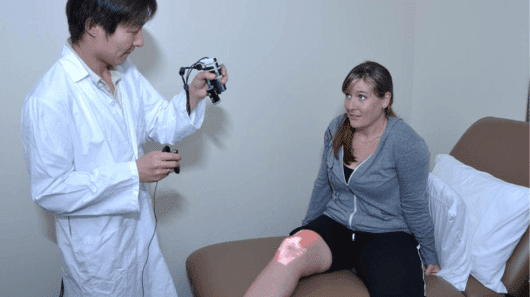
Having undergone some physical therapy myself, I can confirm that even though keeping to a prescribed exercise and treatment regimen helps the injury heal faster, the daunting prospect of self-administered discomfort has led me to ignore the advice of my practitioner.
A team at Microsoft’s research wing has developed a working prototype of a system that may help to encourage physical injury sufferers to do their exercises by giving them a clearer understanding of what’s going on. A therapist would use the device to project a series of graphics of underlying bone, muscle tissue, tendons or nerves directly onto the body of a patient to help explain the nature of the injury and prescribe effective treatment. The device can also take photos during a consultation, which can be subsequently reviewed or printed out as a memory aid for the patient.
It is estimated that up to half of patients undergoing physical therapy for chronic conditions fail to comply with the recommended therapies, and effective communication between patient and practitioner is seen as a major influence for compliance with prescribed exercise regimens. The team of Amy K. Karlson and Daniel Wigdor from Microsoft Research, and PhD student intern Tao Ni from Virginia Tech’s Department of Computer Science, has created a system that could help to enhance such a therapist-patient information exchange.
The AnatOnMe projection-based handheld prototype is made up of two parts. The first consists of an Optoma PK102 pico projector, a Microsoft LifeCam digital webcam and a FireFly MV USB near-infrared camera. The second is a modified Logitech R400 laser pointer which has had its red laser diode replaced by an IR laser diode, and some control buttons added. Both parts are connected to a laptop for processing.
In the hands of a therapist
The therapist controls system functionality with the aid of the laser pointer, which is detected and registered by the system’s near-infrared camera. During a consultation, the practitioner can use the AnatOnMe’s webcam to snap photos of a patient’s injured area and then review using the projector to throw the images onto a nearby wall. As the injury is discussed, the pointer can be used as a descriptive aid or to annotate the projected image. The original or enhanced images can then be added to a patient’s medical records.
The researchers put together a series of annotated graphic collections representing six injury types using stock graphics, three upper body and three lower body injuries that often require physical therapy. Using this library, the therapist can project images onto a patient’s body, a mannequin or a wall, to help the patient better understand an injury through 3D visualization of the problem and then to detail a recommended course of treatment.








